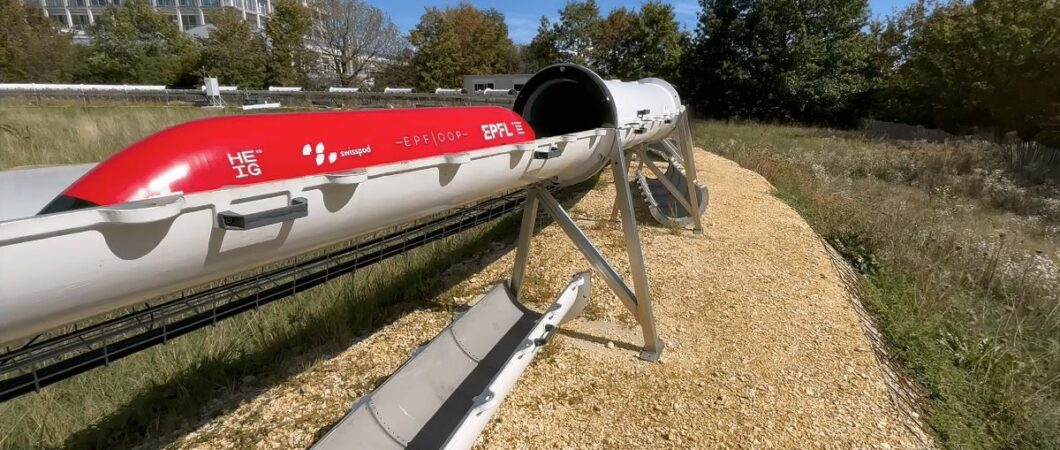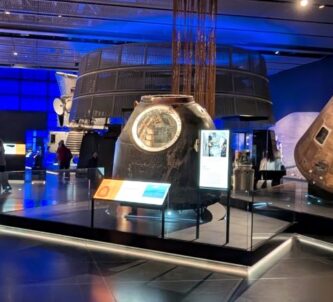The hype over the Hyperloop concept may have died down in recent years, but there are still engineers working to make it a reality. A Swiss team from EPFL, the School of Business and Engineering Vaud (HEIG-VD) and Swisspod Technologies, claim to have broken the record for the longest hyperloop test journey… scaled down.
The Hyperloop idea, promoted widely by Elon Musk in 2013, is that a vehicle travelling in a tube with the air sucked out of it, and suspended electromagnetically, would enjoy frictionless movement without drag, and could thus achieve speeds approaching 1,000 kph (600 mph) providing a high-speed transport alternative to rail and air. A number of international companies and organisations have been working to test and develop the concept. However a few have dropped out of the race in recent years.
EPFL’s LIMITLESS* project, using a 1:12 scale hyperloop vehicle model, has just completed a 141.6 km journey – about the distance between Geneva and Bern, or San Francisco to Sacramento – (11.8 km in reduced scale), at top speeds of up to 488.2 km/h (40.7 km/h in reduced scale) in their circular test track at EPFL within a controlled low-pressure environment.
The test loop has a diameter of 40 centimetres and a circumference of 125.6 metres. It is a scaled-down version (1:12) of the hyperloop system described in the EPFL doctoral thesis of Denis Tudor, the CEO of Swisspod, allowing for a direct correlation between the test results and full-scale performance.

The key aspect of the project is that the infrastructure (the tube) is passive. Unlike other hyperloop designs, it is not transferring any energy to the capsule through energised rails or other systems, which makes it more efficient, more sustainable and reduces the cost of the infrastructure. Most of their efforts are focused on developing a novel Linear Induction Motor (LIM), that will deliver improved performance at high speeds.
“The LIMITLESS project provides an understanding of several fundamental aspects related to the high-speed electromagnetic propulsion of hyperloop capsules. By leveraging this knowledge, we were able to integrate levitation and propulsion functionalities into a single motor with very high energy conversion efficiency,” explains Mario Paolone, professor at DESL.
The team have conducted a total of 82 tests. The experiments at LIMITLESS replicated a hyperloop capsule’s trajectory within a controlled low-pressure environment operated at 50 millibars. During this latest test, the team were closely monitoring the performance of vital subsystems such as the propulsion, communication infrastructure, power electronics, and thermal management. They assessed energy consumption, thrust variations, LIM response, and control during acceleration, cruising, coasting, and braking scenarios.
Future tests at the EPFL facility aim to further validate more efficient versions of the LIM-based hyperloop propulsion and levitation as well as explore the system’s real-world capabilities, limitations, and prospects, while offering vital data for accelerating the path to market deployment.”
Denis Tudor, the CEO of Swisspod said: “This milestone brings us closer to a future where hyperloop becomes a catalyst for societal change. Putting our years of technological innovation to the test is a critical step in pushing the development and deployment of efficient hyperloop technologies worldwide. We’ll soon begin testing our first hyperloop freight transportation product at the larger-scale facility we’re building in the U.S. This is a key step toward making hyperloop for passengers a reality and changing how we connect, work, and live.”
Source: EPFL/Anne-Muriel Brouet
* LIMITLESS is supposed to stand for ‘Linear Induction Motor Drive for Traction and Levitation in Sustainable Hyperloop Systems’, but of course it doesn’t.







